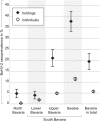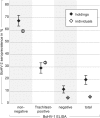Bovine Alphaherpesvirus 2 infections in Bavaria: an analysis of the current situation - several years after eradicating Bovine Alphaherpesvirus 1
- PMID: 32448263
- PMCID: PMC7245791
- DOI: 10.1186/s12917-020-02310-w
Bovine Alphaherpesvirus 2 infections in Bavaria: an analysis of the current situation - several years after eradicating Bovine Alphaherpesvirus 1
Abstract
Background: Bavaria, a large federal state in Germany, has been declared free from infections with Bovine Alphaherpesvirus 1 (BoHV-1) in 2011. To maintain this status the cattle population is monitored for antibodies against BoHV-1 regularly. Several years ago, infrequent but recurrent problems in this sero-surveillance were statistically put into correlation with the presence of antibodies against Bovine Alphaherpesvirus 2 (BoHV-2). In Europe, BoHV-2 is primarily known as the agent causing bovine herpes mammillitis. However, very little information about BoHV-2 infections in Bavaria is available so far. Therefore, the aims of this study were to determine BoHV-2 seroprevalences and to detect virus genomes in potential clinical samples.
Results: 6801 blood sera of healthy cattle from all over Bavaria were tested for antibodies against BoHV-2, revealing an overall seroprevalence of 5.51%. Interestingly, seroprevalences markedly varied between the North and the South of Bavaria, namely from 0.42 to 11.17%. Concurrently, the previously reported relation between the epidemiologically inexplicable sero-reactivities in BoHV-1 ELISAs and the presence of BoHV-2 infections were statistically corroborated in this study. To detect BoHV-2 genomes a fast and sensitive real time PCR was established. Using a multiple PCR strategy, tissue samples from skin lesions at relevant localizations, corresponding lymph nodes, and trigeminal ganglia from 111 animals, as well as nasal swabs from 918 bovines with respiratory symptoms were tested. However, BoHV-2 genomes were not detected in any of these samples.
Conclusions: BoHV-2 antibodies were found in samples from bovines all over Bavaria, albeit with an explicit South-North-divide. BoHV-2 genomes, however, could not be detected in any of the analyzed samples, indicating that acute clinical cases as well as obvious virus reactivation are relatively rare. Consequently, the future spread of BoHV-2 infections throughout Bavaria, particularly, after eradicating BoHV-1, has to be further monitored.
Keywords: Bavaria; BoHV-1; BoHV-2; Bovine Alphaherpesvirus 1; Bovine Alphaherpesvirus 2; Bovine herpes mammillitis; Germany; Real time PCR; Seroprevalence.
Conflict of interest statement
The authors declare that they have no competing interests.
Figures




 ) farms with eleven to 50 animals tested (n = 54), and black ones (♦) farms with more than 50 animals tested (n = 4). Solid horizontal lines indicate the median seroprevalence for the respective region. Dotted lines represent the median of intra-herd BoHV-2 seroprevalences calculated for all of Bavaria
) farms with eleven to 50 animals tested (n = 54), and black ones (♦) farms with more than 50 animals tested (n = 4). Solid horizontal lines indicate the median seroprevalence for the respective region. Dotted lines represent the median of intra-herd BoHV-2 seroprevalences calculated for all of Bavaria
Similar articles
-
Isolation and characterization of bovine alphaherpesvirus 2 strain from an outbreak of bovine herpetic mammillitis in a dairy farm.BMC Vet Res. 2020 Mar 30;16(1):103. doi: 10.1186/s12917-020-02325-3. BMC Vet Res. 2020. PMID: 32228616 Free PMC article.
-
Comparison between DNA Detection in Trigeminal Nerve Ganglia and Serology to Detect Cattle Infected with Bovine Herpesviruses Types 1 and 5.PLoS One. 2016 May 25;11(5):e0155941. doi: 10.1371/journal.pone.0155941. eCollection 2016. PLoS One. 2016. PMID: 27224314 Free PMC article.
-
Full genome sequence of bovine alphaherpesvirus 2 (BoHV-2).Arch Virol. 2021 Feb;166(2):639-643. doi: 10.1007/s00705-020-04895-x. Epub 2020 Dec 14. Arch Virol. 2021. PMID: 33315144 Free PMC article.
-
Biology of bovine herpesvirus 5.Vet J. 2010 May;184(2):138-45. doi: 10.1016/j.tvjl.2009.03.035. Epub 2009 May 5. Vet J. 2010. PMID: 19409823 Review.
-
Distinctive features of bovine alphaherpesvirus types 1 and 5 and the virus-host interactions that might influence clinical outcomes.Arch Virol. 2020 Feb;165(2):285-301. doi: 10.1007/s00705-019-04494-5. Epub 2019 Dec 16. Arch Virol. 2020. PMID: 31845150 Review.
Cited by
-
Involvement of herpesviruses in cases of abortion among water buffaloes in southern Italy.Vet Res Commun. 2022 Sep;46(3):719-729. doi: 10.1007/s11259-022-09887-7. Epub 2022 Jan 26. Vet Res Commun. 2022. PMID: 35080698
References
-
- Virus Taxonomy: 2018b Release. International Committee on Taxonomy of Viruses (ICTV); 2018. https://talk.ictvonline.org/taxonomy/. Accessed 14 Jan 2019.
-
- Janett F, Stauber N, Schraner E, Stocker H, Thun R. Bovine herpes mammillitis: clinical symptoms and serologic course. Schweizer Archiv fur Tierheilkunde. 2000;142(7):375–380. - PubMed
MeSH terms
Substances
Grants and funding
LinkOut - more resources
Full Text Sources

